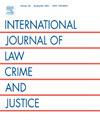Using machine learning to conduct crime linking of residential burglary
IF 1.4
4区 社会学
Q3 CRIMINOLOGY & PENOLOGY
International Journal of Law Crime and Justice
Pub Date : 2024-12-10
DOI:10.1016/j.ijlcj.2024.100716
引用次数: 0
Abstract
Traditional crime linkage methods face challenges with complex datasets, arguably necessitating more sophisticated analytical tools. This research investigates this issue by exploring the application of machine learning, specifically the Random Forest algorithm, as a method to enhance crime linkage analysis of residential burglary cases.
Using a dataset of 200 pairs of linked residential burglaries from the United Kingdom, this study employs the Random Forest technique to examine 67 identified crime features, including those within categories related to inter-crime distance, temporal patterns, such as time and day of the week, target selection, entry behaviour, crime scene conduct, and property stolen.
The key objective is to identify and reduce predictive characteristics that reliably link burglaries, whilst potentially overcoming the limitations of conventional approaches. Findings generally support existing literature but provide increased nuance by indicating that certain factors specifically related to shorter inter-crime distances, the time and date of the offences, and the target's dwelling type, significantly contribute to accurately linking crimes. We discuss these findings in the context of existing research on the subject.
Finally, we consider the benefits of using this novel methodology as a tool for crime linking. We argue that the improved accuracy, interpretability, and provision of multiple decision trees offers significant advantages for refining crime linkage practices, both operationally and in criminological research.
利用机器学习进行住宅入室盗窃的犯罪关联
传统的犯罪联系方法面临着复杂数据集的挑战,可以说需要更复杂的分析工具。本研究通过探索机器学习,特别是随机森林算法的应用,作为一种增强住宅入室盗窃案件犯罪关联分析的方法来研究这一问题。本研究使用来自英国的200对相关住宅盗窃案的数据集,采用随机森林技术来检查67个已确定的犯罪特征,包括与犯罪间距离、时间模式(如一周中的时间和日期)、目标选择、进入行为、犯罪现场行为和财产被盗相关的类别。关键目标是识别和减少可靠连接盗窃的预测特征,同时潜在地克服传统方法的局限性。研究结果总体上支持现有文献,但提供了更多的细微差别,表明某些特定因素与较短的犯罪间距离、犯罪的时间和日期以及目标的居住类型有关,这些因素显著有助于准确地将犯罪联系起来。我们在现有研究的背景下讨论这些发现。最后,我们考虑使用这种新方法作为犯罪联系工具的好处。我们认为,提高准确性、可解释性和提供多决策树为改进犯罪联系实践提供了显著的优势,无论是在操作上还是在犯罪学研究中。
本文章由计算机程序翻译,如有差异,请以英文原文为准。
求助全文
约1分钟内获得全文
求助全文
来源期刊
CiteScore
2.70
自引率
0.00%
发文量
25
审稿时长
47 days
期刊介绍:
The International Journal of Law, Crime and Justice is an international and fully peer reviewed journal which welcomes high quality, theoretically informed papers on a wide range of fields linked to criminological research and analysis. It invites submissions relating to: Studies of crime and interpretations of forms and dimensions of criminality; Analyses of criminological debates and contested theoretical frameworks of criminological analysis; Research and analysis of criminal justice and penal policy and practices; Research and analysis of policing policies and policing forms and practices. We particularly welcome submissions relating to more recent and emerging areas of criminological enquiry including cyber-enabled crime, fraud-related crime, terrorism and hate crime.

 求助内容:
求助内容: 应助结果提醒方式:
应助结果提醒方式:


